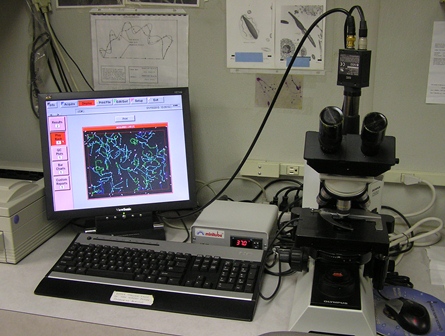 In our previous article, My Stallion is Not Settling His Mares…What Do I Do?, we discussed possible causes for the decline in a stallion’s fertility and areas of reproductive management one can investigate further to determine if the infertility can be suitably managed or resolved. One tool a stallion owner/manager can use to better understand the reproductive status of their stallion is to have a breeding soundness exam (BSE) performed. In this article, Dr. Ed Squires outlines the components of a routine BSE which include: physical exam, reproductive history, testes palpation and/or ultrasound, semen evaluation, cultures and an assessment of his sexual behavior. A BSE provides valuable information on how to manage the stud and gives an indication of the number of mares he could breed.
In our previous article, My Stallion is Not Settling His Mares…What Do I Do?, we discussed possible causes for the decline in a stallion’s fertility and areas of reproductive management one can investigate further to determine if the infertility can be suitably managed or resolved. One tool a stallion owner/manager can use to better understand the reproductive status of their stallion is to have a breeding soundness exam (BSE) performed. In this article, Dr. Ed Squires outlines the components of a routine BSE which include: physical exam, reproductive history, testes palpation and/or ultrasound, semen evaluation, cultures and an assessment of his sexual behavior. A BSE provides valuable information on how to manage the stud and gives an indication of the number of mares he could breed.
Why and When to Have a Breeding Soundness Exam Performed
There are several reasons why a BSE may be performed on a stallion:
- Pre-purchase exam: One reason is for a pre-purchase exam. Ideally, all stallions should have a BSE performed prior to purchase to identify any obvious problems with reproduction anatomy, testicular parameters, sexual behavior or semen quality. It is recommended a stallion have a BSE prior to purchase or have the purchase be dependent upon passing a BSE exam. Finding out the stallion has breeding issues, or is infertile, after purchase could be a financial disaster.
- Insurance purposes: A BSE or some form of reproductive exam and semen analysis may be required in order to secure insurance on a breeding stallion.
- Determination of reproductive performance: When a young horse, or an older horse retiring from a competitive career, first enters the breeding shed a BSE is a valuable management tool to assess reproductive performance and determine how many mares he could breed. When a BSE is performed on an annual basis and considered with respect to the number of mares bred, as well as the resultant pregnancy rates, it can be used to aid in the decision to increase or decrease his book size. It is also helpful in monitoring semen changes and fertility over time. A BSE may highlight potential problems that could be addressed before breeding season begins.
- When a problem has been identified: A BSE may be performed anytime the stallion is suspected of having a breeding problem. This might be prompted by a large number of his mares returning to estrus after being bred, a sudden drop in semen quality, a change in the stallion’s sexual behavior and/or the suspicion that he has a bacterial infection. In my experience, these are the most common reasons for a stallion owner to request a BSE.
How is a Breeding Soundness Exam Performed?
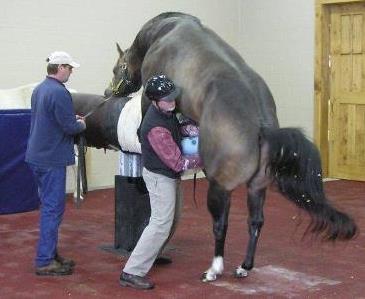 The number of ejaculates that compose a BSE and the tests which are run with the samples can be quite variable depending upon the veterinarian and tests available. In order to determine how many sperm the stallion can ejaculate on a daily basis (daily sperm output - DSO) the stallion needs to be collected daily for 7-10 days or every other day for three weeks. The last few ejaculates could then be used to determine daily sperm output. A value for DSO can be used to predict how many mares the stallion should be booked to in a given breeding season.
The number of ejaculates that compose a BSE and the tests which are run with the samples can be quite variable depending upon the veterinarian and tests available. In order to determine how many sperm the stallion can ejaculate on a daily basis (daily sperm output - DSO) the stallion needs to be collected daily for 7-10 days or every other day for three weeks. The last few ejaculates could then be used to determine daily sperm output. A value for DSO can be used to predict how many mares the stallion should be booked to in a given breeding season.
However, such a frequent collection schedule may be a limiting factor under most circumstances. Therefore, an alternative semen collection protocol is collecting two ejaculates an hour apart, usually done with stallions that have been sexually rested for at least four days. Based on hundreds of BSEs conducted at Colorado State University (CSU), the second ejaculate collected one hour after the first should provide approximately half the sperm. If this relationship does not occur then one knows the stallion incompletely ejaculated on one or both collections, had a small sperm reserve or perhaps accumulated sperm. For more information on sperm accumulation please read our article Sperm Accumulation in the Stallion.
General Physical Exam
The process should begin with verification of identification of the stallion, in order to avoid any legal complications. The physical exam should include a general assessment of body condition, conformation, soundness and neurological function. Pay attention to any issues that may compromise the stallion’s ability to mount the mare or breeding phantom. Horses that are overweight put undue strain on their bodies and as a stallion ages he may develop orthopedic problems in his hocks or stifles. For a stallion to ejaculate comfortably and completely he must not be in pain. The veterinarian should evaluate the stallion in hand and on the mare or phantom during collection for signs of discomfort. If a stallion is dismounting prematurely then one of the potential causes is joint or back pain. Acute or chronic pain may cause a stallion to become uninterested in breeding.
The exam should also make mention of any heritable conditions that may affect breeding ability or desirability as a breeding stallion. The Society for Theriogenology’s manual for clinical evaluation of a stallion lists the following conditions as being genetically controlled: cryptorchidism, combined immunodeficiency, parrot mouth, hemophilia, cataracts and wobbler syndrome. But there may also be breed related genetic diseases that merit notation, e.g. HERDA, HYPP, PSSM.
Examination of the Reproductive Genitalia
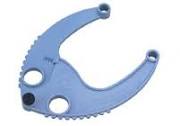 Stallions may not take kindly to having their reproductive anatomy inspected. It is generally preferable to perform the exam after the stallion has been collected and is somewhat quieter in his demeanor. The penis and sheath can be examined at the time the stallion’s penis is washed prior to semen collection; they should be inspected for any lesions, strictures, sores, trauma or swelling. It is also important to make sure the stallion can obtain a rigid, straight erection and that the penis can retract back into the sheath after ejaculation.
Stallions may not take kindly to having their reproductive anatomy inspected. It is generally preferable to perform the exam after the stallion has been collected and is somewhat quieter in his demeanor. The penis and sheath can be examined at the time the stallion’s penis is washed prior to semen collection; they should be inspected for any lesions, strictures, sores, trauma or swelling. It is also important to make sure the stallion can obtain a rigid, straight erection and that the penis can retract back into the sheath after ejaculation.
The testes and epididymides should be evaluated for size, shape, and consistency. A stallion should have two testes descended into the scrotum. Characteristics of the testis that might indicate a problem would include soft, flat, uneven, small or ribbed testicles. Testes can be measured either by using a set of calipers (ARS Scrotal Calipers pictured right) or by ultrasonography. The length (L), width (W), and height (H) of the testicles can be used to calculate the volume of each testicle using the equation: 0.523 (L × W × H) = Testicular Volume.
The stallion's daily sperm output (DSO) can then be predicted by the equation: Total Testicular Volume × 0.024 – 0.76 = DSO.
We recommend the testes be measured once a month during the breeding season and year after year to detect any dramatic changes is size. The accessory sex glands, inguinal rings as well as the aorta and iliac vessels can be evaluated by palpation and ultrasonography per rectum.
Reproductive History
The reproductive history of a stallion is one of the most important parts of the BSE. The following information should be obtained:
- Age (See our article: Declining Fertility in the Aged Stallion)
- Number of mares bred last year and method of breeding (i.e. pasture bred or fresh, cooled or frozen)
- Intended method of breeding - live cover, fresh, cooled, frozen?
- Length of the breeding season
- Pregnancy rates: per cycle, first cycle, and seasonal
- Foaling rates, incidence of abortion or early embryonic loss
- Any evidence of uterine infection in mares previously bred
- Any data from a previous BSE
- Signs of lameness or back problems
- Sudden change in semen quality or change in testis size
- Any fertility problems with other stallions on the same farm
- EVA status or vaccination
- When the stallion last bred or collected
- Is the stallion on any medications, e.g. steroids
- What is his health status? Has he had any recent illness or fever?
Sexual Behavior
During the breeding season stallions should readily obtain an erection when presented to a mare in heat and ejaculate in one or two mounts. See our article the Value of Collecting Semen on One Mount. Stallions requiring more than one or two mounts for ejaculation may have physical or sexual behavioral problems. Alternatively, he may have an issue with the height/placement of the breeding phantom or the artificial vagina (AV) may not have been prepared properly, which could alter the stallion’s willingness to ejaculate.
Semen Evaluation
The essential equipment for a semen evaluation include a phase contrast microscope with a heated stage, sperm counting device and an incubator or water bath to keep semen at 37 degrees Celsius during the evaluation.
Volume and Concentration
The first step is to record the color and consistency of the semen. Sometimes semen contains urine, blood, debris and/or pus. The volume of the ejaculate can be measured in a specimen cup or graduated cylinder but the most accurate way is to weigh the semen since one gram equals one milliliter.
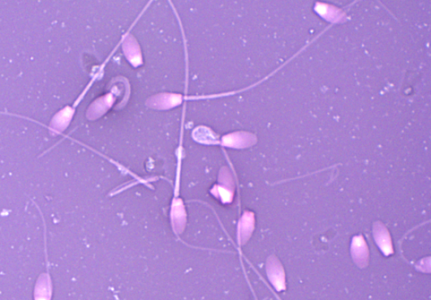 The sperm concentration can be counted with various devices such as densimeters, flow cytometer, Nucleocounter or a hemocytometer. The concentration is then multiplied by the volume to get the total sperm in the ejaculate (concentration x volume = total sperm). Total sperm is the most important parameter since concentration and volume can be quite variable. Once a stallion has been collected enough times to reach DSO then the total sperm obtained on a daily or every other day schedule should be fairly constant. If this is not the case then it could be indicative of a problem such as the stallion is incompletely ejaculating, he is an accumulator or his sperm production may be declining for some reason.
The sperm concentration can be counted with various devices such as densimeters, flow cytometer, Nucleocounter or a hemocytometer. The concentration is then multiplied by the volume to get the total sperm in the ejaculate (concentration x volume = total sperm). Total sperm is the most important parameter since concentration and volume can be quite variable. Once a stallion has been collected enough times to reach DSO then the total sperm obtained on a daily or every other day schedule should be fairly constant. If this is not the case then it could be indicative of a problem such as the stallion is incompletely ejaculating, he is an accumulator or his sperm production may be declining for some reason.
Motility
Most sperm motility is determined looking through a microscope unless a computer-assisted sperm analysis machine (CASA; photo top left) is available. Total motility is the percentage of the sperm that are moving, whereas progressive motility is the percentage of sperm that are moving in a straight line (see our article What is Progressive Motility?). The raw semen should be diluted in a skim milk extender to a concentration of 20-30 million per ml in order to properly evaluate motility. Motility should be estimated once the sperm have been in the extender for 10-15 minutes. The extended sample should be maintained at 37 degrees Celsius until placed on a clean glass slide and put on a heated stage for motility evaluation. It can be difficult to assess motility in raw semen, especially if the sperm concentration is high. However, it is good to get an impression of what the raw semen looks like on a slide just in case there is a big disparity between motility in the extended versus raw semen.
Morphology
A morphological evaluation of sperm is generally done by examining stained sperm at a magnification of 100x under oil emersion. Sperm can be visualized by either being stained with a Hancock stain (photo above left) or diluted in buffered saline and examined as a wet mount. The number of normal sperm as well as those with abnormalities is determined by counting 200 sperm and taking a percentage.
Additional Sperm Testing
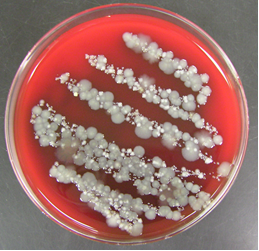 In cases where the value of the stallion is quite high and/or the reproductive problem is not easily discerned, additional tests can be run at certain referral clinics or universities. These include the use of the flow cytometer to determine the percentage of sperm that are acrosome reacted, live/dead, sperm chromatin structure, electron microscope evaluation and mitochondrial activity. These tests are generally not part of a routine BSE.
In cases where the value of the stallion is quite high and/or the reproductive problem is not easily discerned, additional tests can be run at certain referral clinics or universities. These include the use of the flow cytometer to determine the percentage of sperm that are acrosome reacted, live/dead, sperm chromatin structure, electron microscope evaluation and mitochondrial activity. These tests are generally not part of a routine BSE.
Bacteriology
Since bacteria transferred from the stallion to the mare can be a cause of reduced fertility, cultures should be taken from the semen, urethra, urethral fossa and sometimes the prepuce for bacterial isolation. Bacteria that are considered pathogens are Pseudomonas aeruginosa, Klebsiella pneumoniae, Beta-hemolytic strep (e.g. Streptococcus zooepidemicus) and E. coli.
If pathogens are identified and there is a history of repeated infection in mares bred, it may be necessary to breed by artificial insemination using semen extender containing an appropriate antibiotic to which the isolated organism is sensitive. If natural service is required, semen extender containing that antibiotic may be infused into the mare's uterus before servicing.
Conclusion
The big question is: What does a routine BSE tell the client? Since none of these tests are highly correlated with fertility, the BSE cannot predict the exact fertility rate of a stallion. However, it does allow the veterinarian to tell the client if there are any reproductive problems with the stallion. Additionally, it provides information on how many mares the stallion should be able to breed during the breeding season. If a BSE is performed each year, it will allow the stallion manager to know if the stallion’s reproductive parameters are changing faster than they should as well as allude to any physical or behavior problems with the stallion.





